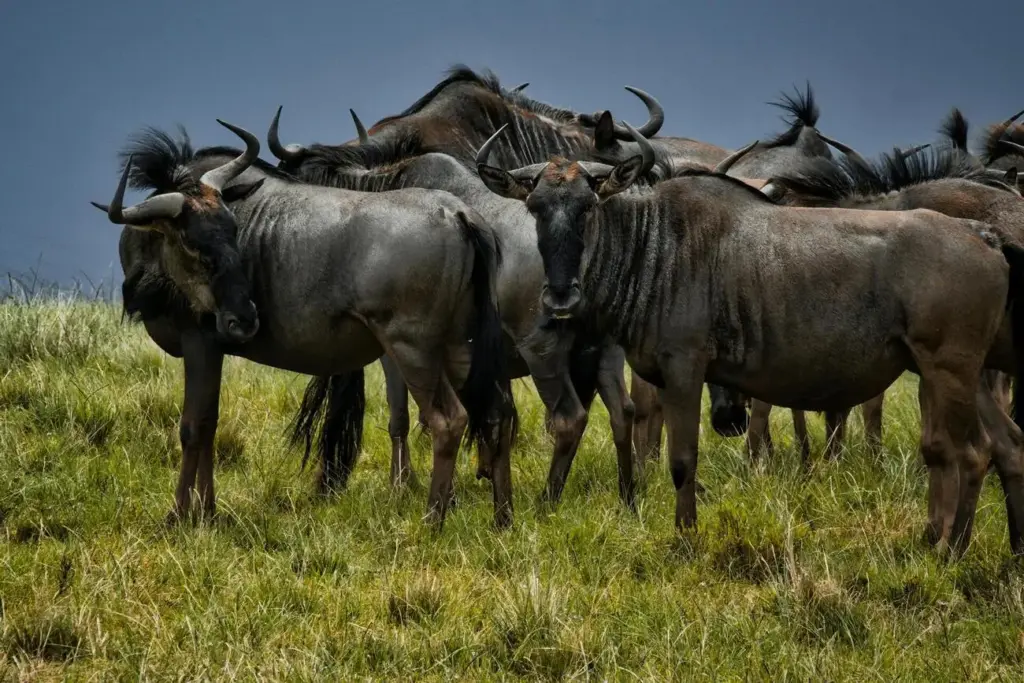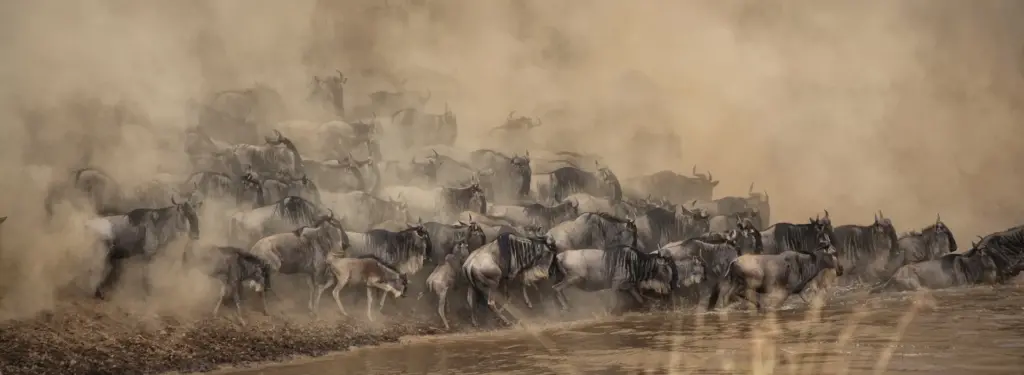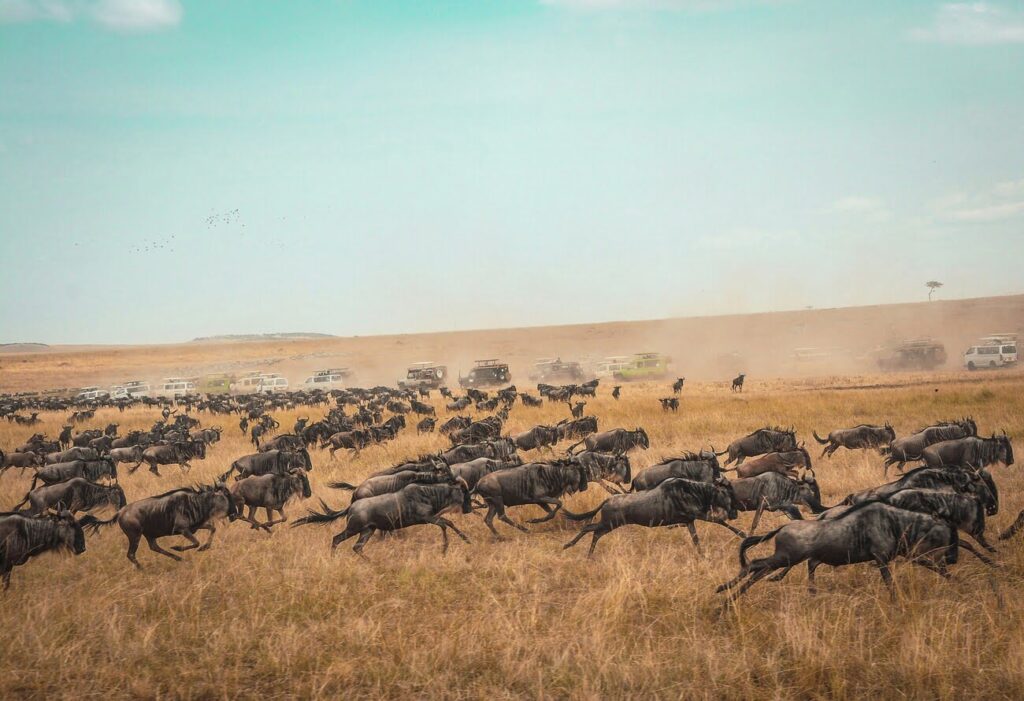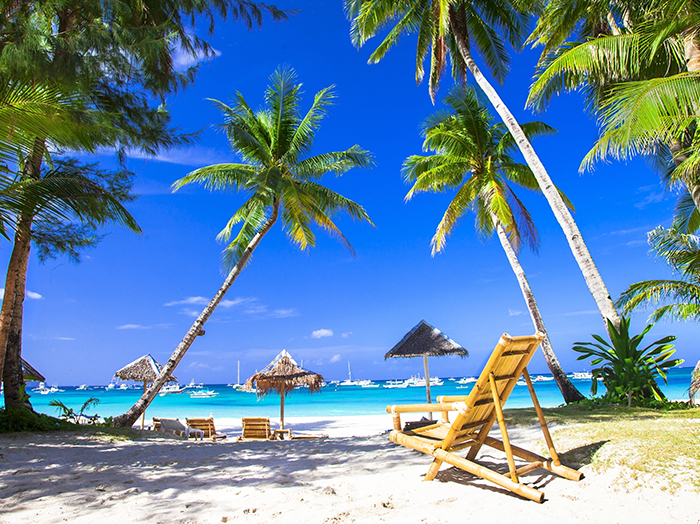Get ready to witness a natural phenomenon so grand, so breathtaking, that the word ‘great’ might just be an understatement! Imagine over 1.5 million wildebeest, a sea of striped zebras totaling 400,000, 12,000 strong eland, and a whopping 300,000 Grant’s and Thomson’s gazelles. This incredible menagerie of animals takes part in a year-long trek from the southern Serengeti to the iconic Maasai Mara. It’s a migration so vast and impressive that it truly deserves its legendary status.
The timing of this natural spectacle is dictated by Mother Nature herself. The herds follow the rains, seeking out the freshest, mineral-rich pastures and life-giving water sources. It’s an 800-kilometer circular journey, a clockwise adventure through the wild and beautiful landscapes of the Serengeti and Maasai Mara ecosystems. While the animals spend a good portion of their time in the vast expanse of Tanzania’s Serengeti, the highlight for many is the months they spend traversing the bountiful plains of Kenya’s Maasai Mara
Exploring the Great Migration
The Great Migration is an annual event that is as old as time itself, yet it never ceases to fascinate and mesmerize those who witness it. This remarkable journey involves over two million wildebeests, zebras, and gazelles moving in a circular route through the Serengeti and the Masai Mara ecosystem in search of fresh pasture and water.
The synchronization of this movement, dictated by the rains and the cycles of nature, creates a dynamic wildlife experience. Observers are not merely passive onlookers but are drawn into the drama and majesty of one of nature’s greatest events.
Planning Your Safari: Best Times to Witness the Migration
To witness the Great Migration in all its glory, timing is everything. The peak season to visit the Masai Mara for the migration is between July and October. During this time, you have the best chance of seeing the dramatic river crossings, where massive herds plunge into crocodile-infested waters in a bold dash for survival.
The Great Migration in January, February and March
The Great Migration is an annual circular journey, and from January to March, the herds are typically found in the southern Serengeti and the Ngorongoro Conservation Area. This period marks the wildebeest birthing season, with approximately 400,000 calves born within a few weeks, providing a feast for predators like lions and hyenas. The short-grass plains of the Ngorongoro Crater highlands offer ideal conditions for the newborn calves, with nutritious grass and safety from predators.

The Great Migration in April and May
During April and May, the Great Migration continues its clockwise journey, with the wildebeest herds moving northwest towards the central Serengeti in search of fresher grass. They are joined by thousands of zebras and smaller groups of antelope, creating a diverse and impressive caravan. The wildebeest start to congregate near the Moru Kopjes, close to Dunia Camp, one of the few accommodations offering migration viewing during this period.
May marks the beginning of the wildebeest mating season, with males engaging in head-to-head battles to win mates. The herds graze leisurely as they make their way towards the Western Corridor of the Serengeti. Ubuntu Migration Camp relocates during this time to provide guests with front-row seats to the wildebeest crossing the Grumeti River, a feast for the Grumeti crocodiles.
May is considered low season, offering excellent value for safaris as there are relatively few tourists, yet the wildlife viewings remain exceptional. The Grumeti River crossings, while not as famous as the Mara River crossings, still provide a spectacular display of nature’s raw power and the circle of life.

The Great Migration: June and July
June marks the beginning of the dry season, and the wildebeest herds concentrate in the Western Serengeti, facing the challenge of crossing the crocodile-infested Grumeti River. This is the first of several daunting river crossings that test the herds’ survival skills.
As June transitions into July, the hundreds of thousands of wildebeest and zebras continue their northward journey along the western edge of the Serengeti National Park. Their destination is the Mara River in the north, where one of The most exciting wildlife events on Earth unfolds. The river crossings typically begin in July, marking the start of the high season, though the exact timing is dictated by nature.

The Great Migration in August, September and October
In August, the herds have braved the challenging Mara River crossings, with many successfully reaching the northern region of the Maasai Mara, while others remain in the northern Serengeti. The river crossings can result in massive losses, with panic, confusion, waiting predators, and strong currents all contributing to the drama. The crocodiles take their toll, and on the riverbanks, lions and other large predators lie in wait for any wildebeest that make it across. The crossings vary in scale, from just a few individuals to masses of animals moving uninterrupted for hours.
By September and October, the main chaos of the river crossings subsides, and the wildebeest columns gradually move eastward. However, the journey is not over, as the herds prepare to face the Mara River once more for their return journey southward. The heavy waters of the river present another challenge, and the cycle of life and death continues.
The Great Migration: November and December
In August, the herds have braved the challenging Mara River crossings, with many successfully reaching the northern region of the Maasai Mara, while others remain in the northern Serengeti. The river crossings can result in massive losses, with panic, confusion, waiting predators, and strong currents all contributing to the drama. The crocodiles take their toll, and on the riverbanks, lions and other large predators lie in wait for any wildebeest that make it across. The crossings vary in scale, from just a few individuals to masses of animals moving uninterrupted for hours.
By September and October, the main chaos of the river crossings subsides, and the wildebeest columns gradually move eastward. However, the journey is not over, as the herds prepare to face the Mara River once more for their return journey southward. The heavy waters of the river present another challenge, and the cycle of life and death continues.
The Circle of Life: Predators of the Masai Mara
The Great Migration is not just about the herds; it’s also about the circle of life that includes the predators that follow them. The Masai Mara is teeming with lions, cheetahs, leopards, hyenas, and crocodiles, all of which are drawn to the abundance of prey.
These predators play a crucial role in the natural selection process, and witnessing their hunting strategies and interactions with the herds adds a thrilling dimension to the safari experience.
Conservation Efforts to Preserve the Great Migration
The Great Migration faces numerous threats, from climate change to human encroachment and poaching. Conservationists are working tirelessly to safeguard this natural wonder for future generations.
Efforts include protecting migration corridors, anti-poaching initiatives, and community outreach programs that emphasize the importance of wildlife conservation and sustainable tourism practices. Visitors play a role too, as each safari contributes to the local economy and funds conservation efforts.


